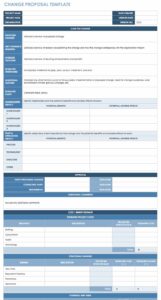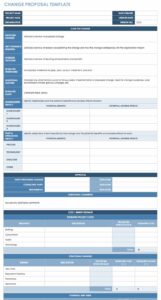Formalized procedures for timeline adjustments offer several advantages. They streamline the process, ensuring modifications are documented and tracked. This documentation helps maintain accountability and provides a clear audit trail. Furthermore, structured forms promote clarity by ensuring all necessary information is included in each request, reducing the need for back-and-forth communication and facilitating faster decision-making. This contributes to better project management and minimizes disruptions caused by miscommunication or incomplete information.
The following sections delve deeper into the practical application of these forms, exploring best practices for creation, implementation, and management. Examples and case studies will further illustrate their value in various scenarios.
Key Components of a Schedule Change Request Form
Effective schedule modification requires clear and comprehensive documentation. Standardized forms ensure all essential information is captured, facilitating efficient processing and informed decision-making. The following components are crucial for a well-designed form:
1: Identification Information: This section clearly identifies the project, task, or event affected by the proposed change. Inclusion of a unique identifier number ensures proper tracking and linkage to the original schedule.
2: Original Schedule Details: A summary of the existing schedule, including key dates and milestones, provides context for the requested changes. This clarifies the impact of the proposed adjustments.
3: Proposed Changes: Specific details of the requested modifications, including new dates, durations, and affected tasks, are essential. Clear articulation of the desired adjustments minimizes ambiguity.
4: Rationale for Change: A concise explanation of the reasons necessitating the schedule change ensures stakeholders understand the justification for the modification. This supports informed decision-making.
5: Impact Assessment: An evaluation of the potential consequences of the proposed changes on other project components, resources, or dependencies is vital. This helps anticipate and mitigate potential risks.
6: Required Approvals: Clearly defined approval workflows and designated individuals responsible for authorizing the changes ensure proper governance and accountability.
7: Supporting Documentation: Any relevant documents, such as revised plans or correspondence, may be attached to provide additional context and support for the request.
Careful consideration of these components ensures comprehensive and well-structured requests, facilitating smooth processing and informed decision-making regarding schedule adjustments. Standardized information capture improves communication and minimizes disruptions during project execution.
How to Create a Schedule Change Request Template
Developing a standardized template for schedule change requests promotes consistency, efficiency, and clarity in managing project timelines. A well-designed template ensures all essential information is captured, facilitating informed decision-making and minimizing potential disruptions.
1: Define Purpose and Scope: Clearly articulate the purpose of the template and the types of schedule changes it will cover. Specifying the scope ensures the template’s relevance and applicability.
2: Determine Required Information: Identify the essential data points to be captured in the request, including project identification, original schedule details, proposed changes, rationale, impact assessment, and required approvals. A comprehensive list ensures all necessary information is collected.
3: Design the Form Layout: Create a clear and user-friendly form structure, organizing information logically for easy comprehension and completion. A well-structured layout improves usability and minimizes errors.
4: Establish Approval Workflows: Define clear approval processes, specifying designated individuals responsible for authorizing changes. This ensures proper governance and accountability.
5: Develop Instructions and Guidance: Provide clear instructions on how to complete the form, including examples and explanations for each section. Comprehensive guidance improves accuracy and reduces ambiguity.
6: Implement and Communicate: Deploy the template within the organization, ensuring all relevant stakeholders are aware of its existence and usage. Effective communication promotes adoption and consistent application.
7: Review and Refine: Periodically review the template’s effectiveness and gather feedback from users. This continuous improvement process ensures the template remains relevant and efficient.
A standardized approach to requesting schedule adjustments improves project management efficiency. Structured templates ensure consistent information capture, facilitate informed decision-making, and contribute to smoother project execution by minimizing disruptions caused by miscommunication and incomplete information.
Standardized forms for requesting schedule adjustments offer significant benefits for organizations managing complex projects. They provide a structured framework for proposing, documenting, and approving modifications, ensuring all essential information is captured and readily accessible. This structured approach facilitates clear communication, reduces misunderstandings, and supports informed decision-making, leading to improved project outcomes and minimized disruptions.
Effective management of change is critical for project success. Implementing standardized procedures for handling schedule adjustments, utilizing well-designed templates, contributes to streamlined processes, improved communication, and increased project efficiency. Organizations prioritizing efficient change management processes position themselves for enhanced project predictability and successful delivery.

